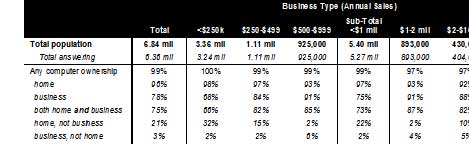Small business loyalty
One consistent trait across all small businesses: loyalty.
Once you land one, it takes significant upheaval, such as a new commercial
loan relationship, before they make a move. NFO research indicates that 81%
of small businesses use the same bank for personal and business services.
And in a survey of Barlow Research clients, about 60% said they kept their
personal and business accounts at the same bank. Evidently, it’s just not
worth the entrepreneur’s time and energy to shop banks, unless they are in
the midst of raising capital. That’s why we believe it is vitally important
to establish a credit relationship with every small business customer
regardless of size.
However, high loyalty is not necessarily the same as high
satisfaction. According to NFO, in 2003 57% of small businesses are very
or extremely satisfied with their primary financial institution, up
from 50% in 2002. This is a mediocre score overall. And with the advent of
the online channel, it is easier than ever to shop around. And since only
22% of small business customers report being actively courted for their
deposits and investments, incumbent financial institution may be vulnerable.
Typically it has been the interaction between the business
owner and the commercial loan officer that has maintained, or sunk, the
relationship. Though personal relationships are still the primary factor,
electronic communications and online services are becoming important side
benefits. The savvy loan or banking officer can use email, instant
messaging, and a Web presence to supplement and extend the face-to-face
relationship. Staying in touch, asking for feedback, and identifying new
needs can all be done through frequent electronic communications.
Growth potential
|
Table 17 Accounting Method by Small Business Type
Source: Online Banking Report, 5/04 |
The small and microbusiness market holds much promise for financial
institutions looking to grow revenues and profits. Smaller businesses, which
are almost 100% computerized (Table 18, next page), are particularly
well-suited for online delivery; however, since most lack dedicated
resources to handle banking matters, they can be reluctant to change
existing processes and procedures. Even though your bank’s latest online
feature may draw an enthusiastic response in focus groups, expect slow
adoption by small business clients. They are simply too busy to pay
attention to incremental banking improvements.
While banks and other financial providers have long coveted the small
business market, most have found it difficult to provide the high-touch
services needed by business owners at prices that a smaller business can
afford. However, we believe small business online banking offers a new
paradigm. Automated online tools and electronic communications such as
instant messaging and webinars, allow banks to deliver customized products
at affordable price points, both for the smallest home-office-based sole
proprietor as well as companies with hundreds of employees.
Table 18
Small business PC ownership

Source: NFO Financial Services Group SOHO/Small Business Owner 2002 Online
and Channel Use